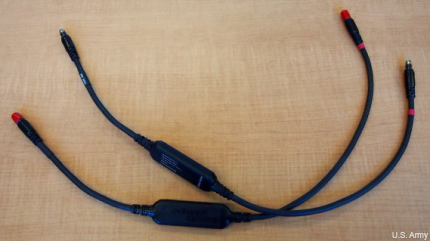Small device, big impact: Linking classified, unclassified nets at the edge
The CERDEC-developed cable connects radios with the Nett Warrior system, feeding soldiers’ locations into the shared operational picture.

The Army is one step closer to being able to securely connect classified and unclassified systems for soldiers at the tactical edge, providing better situational awareness and an improved level of safety for soldiers.
A small cable, the Tactical Army Cross Domain Information Sharing, or TACDIS, connects the unclassified Rifleman Radios used by dismounted soldiers with their classified Nett Warrior smartphones, feeding individual soldiers’ locations into the command-and-control picture.
TACDIS, developed by the Research, Development and Engineering Command’s Communications-Electronics Center, has moved out of its developmental phase and is ready for field testing, AFCEA’s Signal online reports. The device eventually will be set for large-scale production and fielding.
The TACDIS program was started in 2009 after the Army recognized the need—and the potential ability—to include soldiers’ positioning in the operational picture. Rifleman Radios send out geographic location signals that show where a soldier is, but the radios are on an unclassified network. Nett Warrior, which operates on the classified network, is an Android smartphone system — currently using Samsung Galaxy Note II devices — that uses geo-referenced maps to feed the same operational picture to both headquarters and dismounted soldiers.
The TACDIS cable has an AAMP7 microprocessor certified by the National Security Agency to ensure security when transferring that geo-location information to the classified network, according to the Army.
In November 2010, the Army awarded a contract to Rockwell Collins to help develop the device, and the Army started certification testing on the device last September. According to Rockwell Collins, the device uses its MicroTurnstile technology to provide a hardware-based separation kernel, allowing two-way, cross-domain transfer of data, in a cable that weighs only a few ounces and has extremely low power requirements.
Nett Warrior uses chest-mounted smartphones that have been wiped clean and given an NSA-approved version of the Android operating systems and a software package developed by the Army. Most of a phone’s communications functions don’t work (no calls, no Internet), though soldiers can text. Adding soldiers’ locations to the picture would improve command and control, as well as cut down on friendly fire incidents, the Army has said.
Though Nett Warrior is used primarily for situational awareness, the Army has tested other applications with it, such as a system to detect chemical and biological threats.




